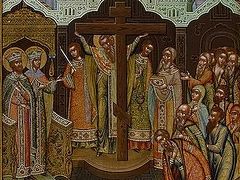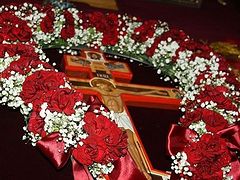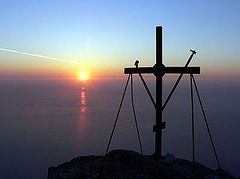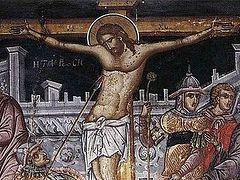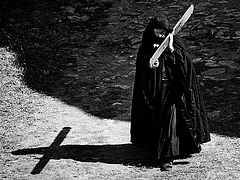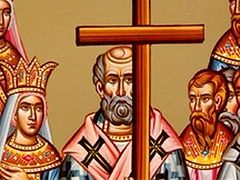The Church is revealed as a second Paradise, having a tree of life, as the first Paradise of old: by touching Thy Cross, O Lord, we share in immortality! (From the Canon of the Third Sunday of Lent)
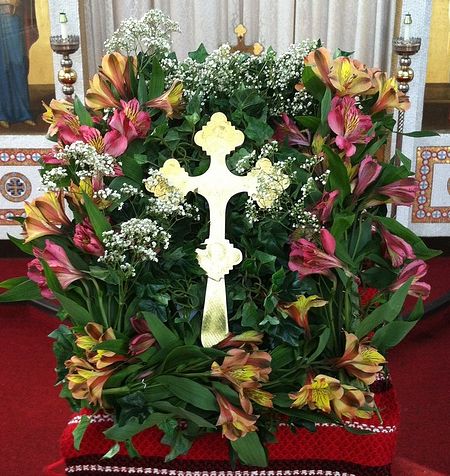
Dear beloved, the third Sunday of Lent, the midpoint of this great annual exercise, is dedicated by the Holy Fathers to the celebration of the Holy Cross. The explanation rests in the Synaxarion of the day: "Since the Holy Cross is also called the tree of life, and this tree has been planted in the center of Paradise, in the same way the Holy Fathers have planted the tree of the Cross in the center of the Great Lent so we can eat from it and live forever."
The Holy Cross has a central place not only during Lent, but also has a central role in our daily life. We make upon ourselves the sign of the Cross in the name of the Holy Trinity every time we pray, enter the Church, venerate an icon or participate in the Holy Liturgy. In everything we do we take the Cross with us for protection and salvation.
Paradoxically the Cross, an ancient instrument of torture and death, radiates life into the world. This may seem odd to the uninitiated observer, but for us, as Christians, we know that at the intersection of its two arms rests the Giver of Life, the maker of the Universe, accepting death so we can receive life.
The tradition says that when the holy Empress Helen went to find the Holy Cross in Jerusalem she unearthed three crosses from the pagan temple of Venus. Trying to decide which one is the true cross of our Savior they brought a sick woman and touched it with the three crosses. When she touched the true Cross, she immediately recovered and the True Cross was therefore revealed. This is the power of the Cross, transformed from an object of death into a fountain of immortality through the one that sacrificed Himself on it.
The Cross has the power to transfigure our lives, because accepting the cross we also accept Christ; the cross becomes therefore the main symbol of our Christian faith. For this reason we receive one at baptism and we carry it around our necks for the rest of our lives. However not all properly understand this symbol. A friend of mine, a non-denominational Protestant lady, who fashions every day various shapes and sizes of crosses, told me one day "I like the crosses but I don't like the Christ on the crosses because is kind of creepy." What she doesn't realize is the fact that if you take Christ away from the Cross, the cross is nothing but ordinary wood.
Christ is the pivotal stone that gives meaning to the Cross, because through Him, nailed with His stretched hands on the wood, man is linked again with God on the vertical axis and the same man is reunited with his brothers on the horizontal.
Jesus died on the cross embracing the world, reuniting at His fatherly breast all those that through sin have grown apart from God and from each other. Thus says St. Athanasius. Through Christ love flows in all directions: from God down to us and from man to man all around.
The cross is the true compass that points toward the only essential cardinal point in our lives: Upwards! Sailing on the sea of life in the motherly ship of the Church, the Cross is the lighthouse that shows us the way home, to the Kingdom of heaven.
Dear beloved, today the Cross of salvation is taken into precession around the Church on a bed of daffodils. The daffodils are chosen because as the first flowers of spring, the time when nature is reborn, they remind us of Resurrection. We do this because we cannot think of the Cross without remembering of Resurrection. We cannot imagine the death and the passions of Christ without having in mind the empty tomb radiating hope. Christ’s death has no meaning without His Resurrection.
The Orthodox have always emphasized this aspect of balance and have never inclined toward exaggerating the suffering, as happened many times in the Western depictions of Crucifixion.
In any Orthodox Crucifixion Christ is shown as standing on the cross, almost supporting it, not hanging on it. Even though Christ suffered on the Cross, the image does not lose its peace and pondered sadness, because our Lord willingly took the Cross for us, knowing that the Resurrection follows. The Orthodox icon of Crucifixion radiates peace and hope.
Some of the Western crucifixion depictions however, like the Grunewald crucifixion, one of the most famous Renaissance scenes, reflect the opposite. Christ, the Savior of the world, is represented as a horrible corpse nailed to a cross, with a body contorted in a grueling agony, a repulsive sight from which the viewer turns away in horror. It is nothing other than a work of despair that casts away every hope from the Christian soul. No one looking at this sight could hope in the Resurrection and in eternal life. Other modern renderings like the movie of Mel Gibson, The Passions of Christ, suffer from the same disease: too much suffering and much less hope.
As Orthodox we do not have this vision of pain. We know that Christ suffered on the cross, but we rejoice at the sight of the Cross, because we know what follows. Therefore we adorn our Cross with daffodils and continue our journey toward Resurrection.
Let us therefore rejoice once again at the sight of the elevated Holy Cross and sing in unison, “Come, all faithful, let us venerate the holy resurrection of Christ. For behold, through the cross joy has come to all the world. Blessing the Lord always, let us praise His resurrection. For enduring the cross for us, He destroyed death by death." Amen.

